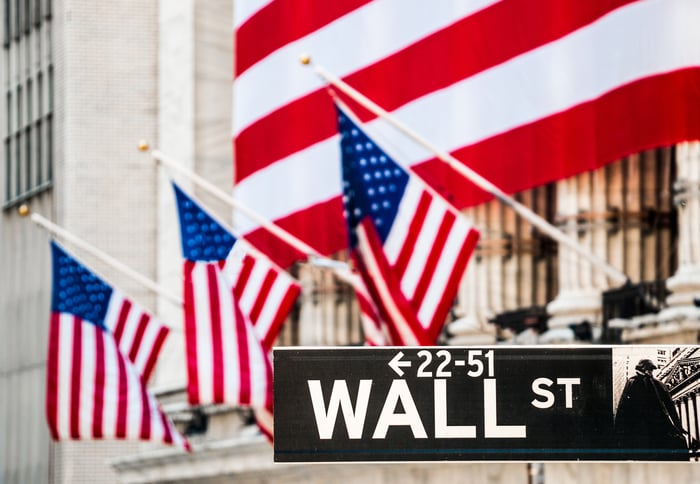For more than 125 years, the iconic Dow Jones Industrial Average (^DJI -0.98%) has served as a barometer of Wall Street's health. Although far from perfect, the Dow Jones is comprised of 30 time-tested, multinational companies that have a long track record of making their shareholders richer.
As we move into the warm summer days of August, three Dow Jones stocks stand out as particularly attractive. If you have cash on the sidelines and are looking for an effective way to put that money to work over the long run, the following trio of Dow components may be the answer.

Image source: Getty Images.
Salesforce.com
Arguably the most-exciting stock within the Dow Jones is its fastest-growing component, cloud-based customer relationship management (CRM) software provider Salesforce.com (CRM -1.10%).
In simple terms, CRM software is designed to help consumer-facing businesses manage their clients' information. Businesses employ CRM software to log and access client information in real-time, manage online marketing campaigns, oversee service issues, analyze relationships, and offer predictive analyses that can determine which customers would be most likely to purchase a new product or service. As more industries hop on board the CRM trend, we're liable to see double-digit sales growth sustained through mid-decade, if not considerably longer.
Salesforce slides in as the most-dominant global CRM player. When IDC examined global CRM spending during the first-half of 2020, it found that Salesforce gobbled up just a hair shy of 20% of worldwide CRM revenue. The next four competitors -- Oracle, SAP, Adobe, and Microsoft -- don't even add up to Salesforce's CRM share on a combined basis. As the clear go-to for CRM, Salesforce's revenue has grown by a compound annual rate of 29% over the past decade and 51% over the trailing 20 years.
While Salesforce is doing a fine job of expanding organically, CEO Marc Benioff hasn't been shy about making acquisitions to expand the company's reach. Purchasing MuleSoft and Tableau has worked out marvelously for the company, and I anticipate the recently closed buyout of cloud-based enterprise communications platform Slack Technologies will bring similar accretive growth opportunities over the long run. In particular, Slack's communications platform can be used as a cross-selling tool for Salesforce to reach new small-and-medium-sized businesses.
As one final note, Benioff has stuck by his forecast that Salesforce will reach at least $50 billion in annual sales by fiscal 2026, up from the $21.3 billion recorded in fiscal 2021. If the company can sustain this 20%-plus annual growth rate, its current share price is an absolute steal.

Image source: Visa
Visa
Another Dow stock that investors can confidently buy hand over fist in August is payment processing behemoth Visa (V 0.05%).
Last week, investors couldn't mash the sell button fast enough on payment facilitators after fintech stock Square (SQ -1.68%) announced that it would acquire Australia's Afterpay in an all-share deal initially valued at $29 billion. The purchase of the buy now, pay later giant is an effort by Square to create a cohesive payments ecosystem that links its exceptionally fast-growing digital payments platform Cash App with its foundational seller ecosystem. In other words, there was instant concern on Wall Street that other payment processors, including Visa, would be pushed out of the loop.
But if we've learned anything over the years, it's that a decline in Visa's share price is a buying opportunity. While it's clear that Square is attempting to expand its brand globally, Visa's utter dominance domestically and growing presence globally makes it unlikely that it'll be unseated as the payments leader anytime soon.
For instance, Visa controlled a 53% share of U.S. credit card network purchase volume in 2018. Its next-closest competitor was more than 30 percentage points behind it. The U.S. is the leading global market for consumption, which puts Visa in the driver's seat to take advantage of disproportionately long periods of economic expansion.
Visa has an exceptionally long and sustainable growth runway, as well. It can lean on acquisitions (e.g., the Visa Europe buyout in 2016), if necessary, to expand its reach, or it could simply push its infrastructure into underbanked markets. With much of the world's transactions still being conducted in cash, Visa's long-term opportunity is likely bigger than you realize.

Image source: Getty Images.
Verizon Communications
Don't worry, value stock and income-seeking investors, I haven't forgotten about you. The third and final Dow stock to buy hand over fist in August is arguably the least volatile Dow component, Verizon Communications (VZ -0.68%).
Verizon has absolutely no shot of matching Salesforce and Visa in the growth department. However, the predictability of its cash flow, the clearness of its two core catalysts, and its premier dividend make it a stock to own.
The biggest catalyst for Verizon is unquestionably the rollout of 5G wireless infrastructure. It's been a decade since wireless download speeds were substantively improved, which means 5G offers an opportunity for consumers and enterprises to upgrade their devices to take advantage of these faster speeds. This technology upgrade cycle isn't going to happen overnight, which'll provide Verizon with a multiyear opportunity to sustainably boost its organic wireless growth. Remember, wireless data is Verizon's juiciest margin driver. If customers are consuming more data, chances are Verizon's wireless operating margins are headed higher.
The second catalyst for Verizon is its ongoing push into broadband services. The company opened its wallet wide to purchase 5G mid-band spectrum earlier this year. The goal here is to have broadband services in 30 million households by the end of 2023.
And who can overlook Verizon's market-topping 4.5% dividend yield? This payout is rock-solid -- an estimated payout ratio of 49% in 2021 -- and can help income-seeking investors offset rapidly rising short-term inflation.
Paying less than 11 times projected earnings per share for Verizon and netting 4.5% annually for your patience is a discount for such a solid company.





